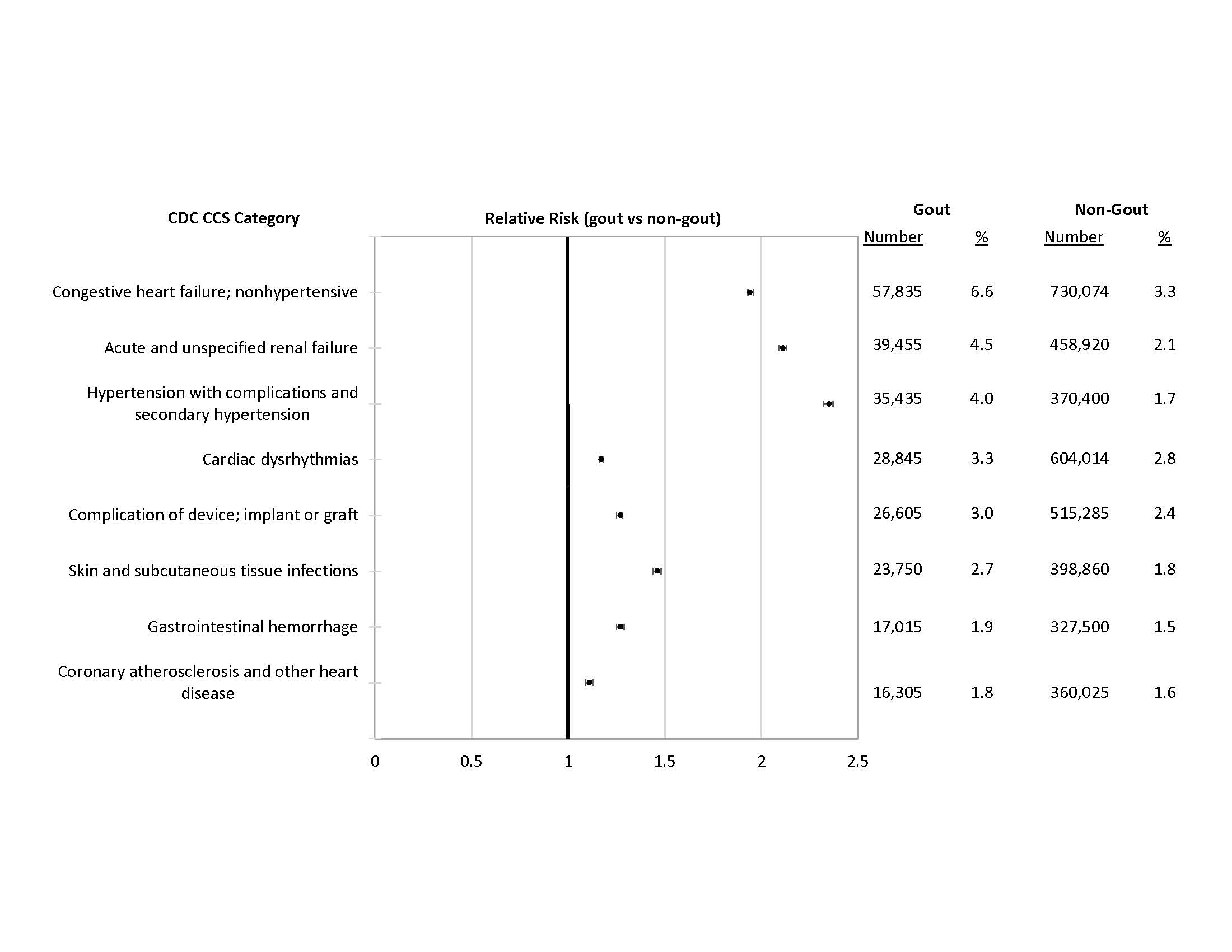Session Information
Session Type: Poster Session (Sunday)
Session Time: 9:00AM-11:00AM
Background/Purpose: Gout is a disorder of uric acid metabolism and often presents as acute severe joint pain. Previous work from our group suggests that all-cause hospitalizations in patients with gout in the United States (US) have significantly increased in the last 22 years. The current study focused on identifying potential reasons for the excess hospitalizations.
Methods: The Nationwide Inpatient Sample (NIS) is a stratified random sample of all US community hospitals. It is the only US national hospital database with information on all patients, regardless of payer, including persons covered by Medicare, Medicaid, private insurance, and the uninsured. We examined all inpatient hospitalizations in the NIS in 2016 among patients 40 years or older with a primary or secondary diagnosis of gout and compared them to total all-cause hospitalizations in patients without a gout diagnosis in the same age group during the same period. Over 69,800 ICD 10 diagnoses codes were collapsed into a smaller number of clinically meaningful categories, consistent with the Centers for Disease Control (CDC) Clinical Classification Software. The top 15 primary causes for hospitalization were evaluated and compared between the two cohorts.
Results: In 2016, there were 892,379 all-cause hospitalizations in the US in patients with gout with 14,135 (1.6%) of these for primary diagnosis of gout. The primary diagnoses for remaining 878,244 hospitalizations in patients with gout were compared with those in 21.9 million hospitalizations in the general US population without gout. The most common primary cause of hospitalizations in both cohorts was septicemia (7.8% in gout vs. 7.4% in general population). Significant differences were seen in several other categories. For example, acute renal failure was twice as frequent among gout patients (39,455 hospitalizations, 4.5%) compared to the general population (458,920 hospitalizations, 2.1%) (Relative Risk (RR) 2.11, 95% CI 2.08 – 2.13, p< 0.0001). Hospitalizations for “hypertensive complications and secondary hypertension” were also higher (35,435, 4.0% in gout vs 370,400, 1.7% in general population, RR 2.35, 95% CI 2.32 – 2.37, p< 0.0001). Hospitalizations from gastrointestinal bleeding were 30% more common in gout patients, perhaps associated with concomitant NSAID treatments (Figure).
Conclusion: Among patients with gout, a far greater proportion of serious hospitalizations are related to renal and cardiovascular complications as compared to age-matched general population.
This calls for an increased awareness and management of serious co-morbid conditions in patients with gout.

Figure Relative risk of comorbidities in Gout vs No Gout
To cite this abstract in AMA style:
Mithal A, Sehgal M, Singh G. Gout in the US: Significant Association with Cardiovascular and Renal Disease Hospitalizations – A Nationwide Study [abstract]. Arthritis Rheumatol. 2019; 71 (suppl 10). https://acrabstracts.org/abstract/gout-in-the-us-significant-association-with-cardiovascular-and-renal-disease-hospitalizations-a-nationwide-study/. Accessed .« Back to 2019 ACR/ARP Annual Meeting
ACR Meeting Abstracts - https://acrabstracts.org/abstract/gout-in-the-us-significant-association-with-cardiovascular-and-renal-disease-hospitalizations-a-nationwide-study/
